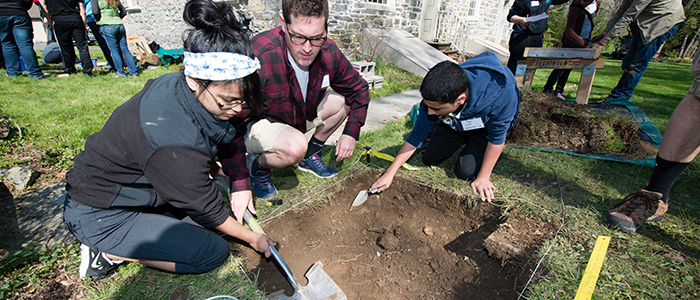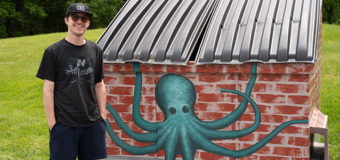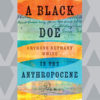State System Faculty Studying Ways to Build A Faster Boat, Battle Alzheimer’s Disease And Boost Classroom Learning

Posted by: admin on July 22, 2014, No Comments

Organized by Dr. Doug Lare, an ESU professor of professional and secondary education, ESU students and middle-level students from Allentown, Pa., and Bethlehem, Pa., participate in a “mock dig” in April at the Governor Wolf Historical Association site.
West Chester University of Pennsylvania professor Frank Fish would seem to be aptly named for his line of work. The “morphobiologist” is part of a research team that is studying how dolphins, whales and other sea creatures swim to see if they can figure out a way to make boats go faster.
The team, which also includes researchers from the University of Virginia, Harvard, Princeton and Lehigh, will receive $1.5 million a year from the U.S. Department of Defense over the next five years to study the hydrodynamics of non-traditional propulsion – fins vs. propellers, if you will.
“We’re looking at fast swimmers with flexible flukes – dolphins, whales, tuna and trout – to explore the possibility of a system that could replace propellers for underwater propulsion,” Fish said. “What are the performance differences between a narrow, rigid tail fin like the tuna’s and the flexible fin of a dolphin? What are the tradeoffs in quietness, efficiency, thrust production?”
Fish is conducting some of his research in the Liquid Life Lab at West Chester. He also will conduct studies at the National Aquarium in Baltimore, the University of California-Santa Cruz and the Cook Islands in the South Pacific, where there is a renowned whale sanctuary.
The West Chester University professor is among a large number of State System of Higher Education university faculty involved in high-level research this summer, funded by groups such as the National Science Foundation, the Centers for Disease Control and Prevention and NASA, along with a variety of state and federal agencies. Many are involving their students in their projects, providing them with hands-on learning opportunities that will help kick start their eventual careers.
“State System universities have a rich reputation as institutions focused on undergraduate education, and organized research certainly can be a great teaching tool,” said Chancellor Frank T. Brogan. “Our students have tremendous opportunities to work alongside outstanding faculty regarding some very compelling projects.”
Cheyney University of Pennsylvania students Chandra Gadsden and Khalid Habib are among those receiving that opportunity. They are working this summer with their professor, Dr. Abeliaziz Bior, who is conducting research on Alzheimer’s disease at Brookhaven National Laboratory in Upton, N.Y., as part of a collaborative effort between the Louis Stokes Alliance for Minority Participation Program and the National Science Foundation.
Dr. James Hunt, an associate professor of biological sciences at East Stroudsburg University of Pennsylvania, is a member of the PICASSO Research Team based in Japan. PICASSO is a state-of-the-art, submersible, remotely operated vehicle – a kind of submarine – engineered to explore the deep oceans and collect valuable data on living specimens. In recent years, the PICASSO team has made a number of discoveries that are contributing to the overall understanding of the deep sea and its potential influence on global climate.
Dr. Hunt travels to Japan for a research cruise about once every two years. In April 2012, he and then-ESU senior Diona Drake participated on a research cruise run by the University of Tokyo, during which they collected physical and chemical data from the ocean depths as well as biological specimens, including several new species. Ms. Drake has since been accepted to graduate school at the University of Guam to pursue her interest in deep-sea fishes.
Two of Dr. Hunt’s ESU colleagues currently are engaged in a five-year, $965,000 grant-funded research project through the Centers for Disease Control and Prevention and administered by the Pennsylvania Department of Health. Dr. Steve Godin, professor of health studies, and Dr. Alberto Cardelle, professor of health studies and interim dean of ESU’s College of Health Sciences, are conducting a range of studies, including the evaluation of food service guidelines and nutrition standards for schools and worksites, and look at physical activity programs in early childhood settings. They also are evaluating the use of electronic health records in the prevention and management of diabetes and high blood pressure.
Dr. Cardelle also is spearheading a partnership with Pocono Health System to conduct a community health needs assessment of the Pocono region. The goal is to assess the overall health status and health needs of the local community, what health care services are actively being used and what actions need to be taken in the future to address these needs. The study is designed to provide PHS with critical data that will allow it to better serve the residents of Monroe County and surrounding communities.
The Pocono region study is an example of research being conducted by State System faculty that will benefit the immediate campus community and surrounding region.
Similarly, Dr. Heather Bechtold and Dr. Steven Seiler of Lock Haven University of Pennsylvania are working with the U.S. Department of Agriculture and U.S. Forest Service to conduct a large-scale forest stream survey of sensitive fish species in the Allegheny National Forest. The purpose of the project is to determine the distribution of fish species and algal communities in streams throughout the forest, as well as determine water chemistry and stream water quality. A number of LHU undergraduate students also are working on the project.
At California University of Pennsylvania, several faculty are participating in the Highly Qualified Teachers in Exceptional Education (HG-TEEMS) program, which is being funded through a $500,000 grant from the U.S. Department of Education. About 30 teachers from the California, Connellsville Area and Washington school districts and the Mon Valley School, which is part of the Allegheny Intermediate Unit, participated in the program, which was led by Cal U. faculty, including Dr. Katherine Mitchem and Dr. Kalie Kossar.
The HQ-TEEMS program helps special education teachers meet the state Education Department’s requirements to become designated as “highly qualified teachers” in math and science. The program included both classroom instruction as well as outdoor activities. At Mingo Creek Park, Cal U. professors Dr. David Argent and Dr. Jason Kight used hands-on activities to teach educators about stream ecology and the food chain.
Two Shippensburg University of Pennsylvania professors also are involved in grant-funded research projects through NSF that could help boost the quality of teaching. Dr. Doug Ensley is working on a mathematics application for calculus and Dr. Ben Galluzzo is studying the effect of incorporating environmental sustainability with undergraduate math education. A university colleague, Dr. Clair Jantz, has received a grant from NASA to map and monitor wetlands.
A pair of Bloomsburg University of Pennsylvania professors will be using and sharing their expertise overseas, as recipients of prestigious Fulbright scholarships. Michael Hickey, a history professor, is spending the summer in Russia, continuing his research on Jewish history at Smolenski State University, while Mehdi Razzaghi, a professor of mathematics, statistics and computer science, will spend this coming academic year conducting research and teaching a graduate course at the University of Warsaw in Poland.
Dr. Doug Lare, a professor of professional and secondary education, at East Stroudsburg University, brought together ESU professors and students, urban middle school students and their teachers, local historical society organizations and professional archeologists, for the continuation of a unique research project this April and May involving the historic Ralsteen-McKeen house, which was built in 1795. Pre-service teachers worked with middle level students in Allentown and Bethlehem teaching them about basic archeology, participating initially in a “mock dig” in April at the Governor Wolf Historical Association site.
The ESU students took part in an actual archeological dig beginning in May, uncovering a wide range of artifacts. The middle level urban students learned how real archeologists work; the ESU pre-service teachers learned how to actively engage students; and, perhaps most important, the university, historical society and school districts learned how to work together in order to achieve common educational goals.
The Pennsylvania State System of Higher Education is the largest provider of higher education in the Commonwealth, with about 112,000 students. The 14 State System universities offer degree and certificate programs in more than 120 areas of study.
The universities are Bloomsburg, California, Cheyney, Clarion, East Stroudsburg, Edinboro, Indiana, Kutztown, Lock Haven, Mansfield, Millersville, Shippensburg, Slippery Rock and West Chester Universities of Pennsylvania. The universities also operates branch campuses in Oil City (Clarion), Freeport and Punxsutawney (IUP) and Clearfield (Lock Haven), and offer classes and programs at several regional centers, including the Dixon University Center in Harrisburg and in Center City in Philadelphia.
What is one thing a professor has taught you from his or her own research or study that you continue to use in your career? #PASSHE
Check out what their former students are saying about their State System university professors at www.facebook.com/statesystem http://www.facebook.com/statesystem.




